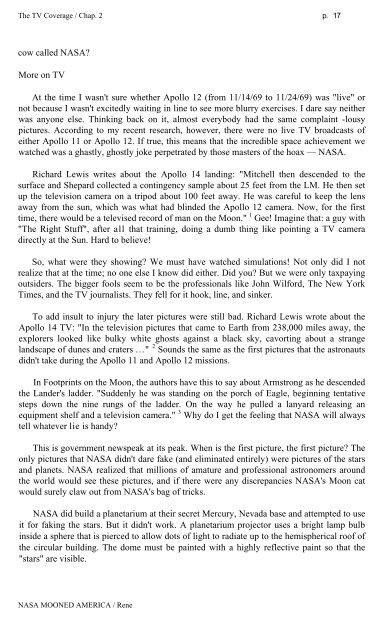Rene-NASA-Mooned-America
Rene-NASA-Mooned-America
Rene-NASA-Mooned-America
Create successful ePaper yourself
Turn your PDF publications into a flip-book with our unique Google optimized e-Paper software.
The TV Coverage / Chap. 2 p. 17<br />
cow called <strong>NASA</strong><br />
More on TV<br />
At the time I wasn't sure whether Apollo 12 (from 11/14/69 to 11/24/69) was "live" or<br />
not because I wasn't excitedly waiting in line to see more blurry exercises. I dare say neither<br />
was anyone else. Thinking back on it, almost everybody had the same complaint -lousy<br />
pictures. According to my recent research, however, there were no live TV broadcasts of<br />
either Apollo 11 or Apollo 12. If true, this means that the incredible space achievement we<br />
watched was a ghastly, ghostly joke perpetrated by those masters of the hoax — <strong>NASA</strong>.<br />
Richard Lewis writes about the Apollo 14 landing: "Mitchell then descended to the<br />
surface and Shepard collected a contingency sample about 25 feet from the LM. He then set<br />
up the television camera on a tripod about 100 feet away. He was careful to keep the lens<br />
away from the sun, which was what had blinded the Apollo 12 camera. Now, for the first<br />
time, there would be a televised record of man on the Moon." 1 Gee! Imagine that: a guy with<br />
"The Right Stuff", after all that training, doing a dumb thing like pointing a TV camera<br />
directly at the Sun. Hard to believe!<br />
So, what were they showing We must have watched simulations! Not only did I not<br />
realize that at the time; no one else I know did either. Did you But we were only taxpaying<br />
outsiders. The bigger fools seem to be the professionals like John Wilford, The New York<br />
Times, and the TV journalists. They fell for it hook, line, and sinker.<br />
To add insult to injury the later pictures were still bad. Richard Lewis wrote about the<br />
Apollo 14 TV: "In the television pictures that came to Earth from 238,000 miles away, the<br />
explorers looked like bulky white ghosts against a black sky, cavorting about a strange<br />
landscape of dunes and craters ..." 2 Sounds the same as the first pictures that the astronauts<br />
didn't take during the Apollo 11 and Apollo 12 missions.<br />
In Footprints on the Moon, the authors have this to say about Armstrong as he descended<br />
the Lander's ladder. "Suddenly he was standing on the porch of Eagle, beginning tentative<br />
steps down the nine rungs of the ladder. On the way he pulled a lanyard releasing an<br />
equipment shelf and a television camera." 3 Why do I get the feeling that <strong>NASA</strong> will always<br />
tell whatever lie is handy<br />
This is government newspeak at its peak. When is the first picture, the first picture The<br />
only pictures that <strong>NASA</strong> didn't dare fake (and eliminated entirely) were pictures of the stars<br />
and planets. <strong>NASA</strong> realized that millions of amature and professional astronomers around<br />
the world would see these pictures, and if there were any discrepancies <strong>NASA</strong>'s Moon cat<br />
would surely claw out from <strong>NASA</strong>'s bag of tricks.<br />
<strong>NASA</strong> did build a planetarium at their secret Mercury, Nevada base and attempted to use<br />
it for faking the stars. But it didn't work. A planetarium projector uses a bright lamp bulb<br />
inside a sphere that is pierced to allow dots of light to radiate up to the hemispherical roof of<br />
the circular building. The dome must be painted with a highly reflective paint so that the<br />
"stars" are visible.<br />
<strong>NASA</strong> MOONED AMERICA / <strong>Rene</strong>


